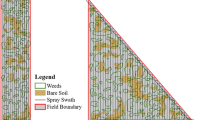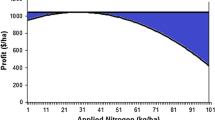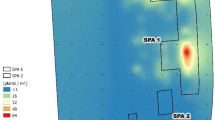Abstract
Understanding how field geometry is related to over-application of inputs may help farmers make more informed decisions about investment in automatic section control (ASC) technology. The technology helps reduce input application overlap and therefore reduces input costs. The influence of field geometry on the profitability of ASC technology for chemical application was evaluated using overlap data estimated for 44 farm fields in Tennessee, USA. Reduction in overlap with ASC was defined as the difference in area sprayed controlling the entire boom as one section and area sprayed using seven-section ASC. Perimeter (m)-to-area (m2) ratio (P/A, m−1) was used to categorize estimated chemical overlap by field size and shape. Estimated median reductions in overlap with ASC were 3.00 % for fields with P/A = 0.01, 9.65 % for fields with P/A = 0.02 and 13.50 % for fields with P/A ≥ 0.03. For a typical size cotton farm in Tennessee, investing in ASC was not likely to be profitable for fields with P/A = 0.01 but was generally profitable for fields with P/A ≥ 0.02. The low reduction in overlap for P/A = 0.01 with ASC resulted in chemical savings that were too small to pay back the investment in ASC within the useful life assumed for the technology and provide a minimum rate of return. Thus, P/A as a measure of field geometry may be useful for evaluating investments in ASC technologies.





Similar content being viewed by others
References
ASABE. (2011). Agricultural Machinery Management Data. ASAE D497.7. St. Joseph, MI: American Society of Agricultural and Biological Engineers.
Batte, M. T., & Ehsani, M. R. (2006). The economics of precision guidance with auto-boom control for agricultural sprayers. Computers and Electronics in Agriculture, 53(1), 28–44.
Bennett, A. L., & Pannell, D. J. (1998). Economic evaluation of a weed-activated sprayer for herbicide application to patchy weed populations. Australian Journal of Agricultural & Resource Economics, 42, 389–408.
Bhandari, S. B. (2009). Discounted payback period-some extensions. Journal of Business and Behavioral Sciences, 21, 28–39.
Clemen, R. T., & Reilly, T. (2001). Making hard decisions. Pacific Grove, CA: Duxbury Press.
Gibbons, J. D., & Chakraborti, S. (2011). Nonparametric statistical inference. Boca Raton, FL: CRC Press.
Jernigan, B. (2012). Defining and modeling parameters associated with double-planted areas in row crop production fields. M.S. Thesis, The University of Tennessee Knoxville, TN.
Larson, J. A., Mooney, D. F., Roberts, R. K., & English, B. C. (2010). A computer decision aid for the cotton precision agriculture investment decision. In R. Khosla (Ed.), Proceedings of the 10th International Conference on Precision Agriculture. ISPA: Monticello, IL.
Lowenberg-Deboer, J. (1999). Risk management potential of precision farming technologies. Journal of Agricultural and Applied Economics, 31, 275–285.
Luck, J. D., Pitla, S. K., Shearer, S. A., Mueller, T. G., Dillon, C. R., Fulton, J. P., et al. (2010a). Potential for pesticide and nutrient savings via map-based automatic boom section control of spray nozzles. Computers and Electronics in Agriculture, 70(1), 19–26.
Luck, J. D., Zandonadi, R. S., Luck, B. D., & Shearer, S. A. (2010b). Reducing pesticide over-application with map-based automatic boom section control on agricultural sprayers. Transactions of the ASABE, 53(3), 685–690.
Luck, J. D., Zandonadi, R. S., & Shearer, S. A. (2011). A case study to evaluate field shape factors for estimating overlap errors with manual and automatic section control. Transactions of the ASABE, 54(4), 1237–1243.
Maine, N., Lowenberg-DeBoer, J., Nell, W. T., & Alemu, Z. G. (2009). Impact of variable rate application of nitrogen on yield and profit; A case study from South Africa. Precision Agriculture, 11, 448–463.
National Research Council. (1997). Precision Agriculture in the 21st Century: Geospatial and Information Technologies in Crop Management. Washington DC: National Academy Press.
Oriade, C. A., King, R. P., Forcella, R. F., & Gunsolus, J. L. (1996). A bioeconomic analysis of site specific management for weed control. Review of Agricultural Economics, 18, 523–535.
Robertson, M., Carberry, P., & Brennan, L. (2007). The economic benefits of precision agriculture: case studies from Australian grain farms. http://www.grdc.com.au/uploads/documents/Economics%20of%20Precision%20agriculture%20Report%20to%20GRDC%20final.pdf. Accessed 10 June 2015.
Shockley, J., Dillon, C. R., Stombaugh, T., & Shearer, S. (2012). Whole farm analysis of automatic section control for agricultural machinery. Precision Agriculture, 13(4), 411–420.
Smith, C. M., Dhuyvetter, K. C., Kastens, T. L., Kastens, D. L., & Smith, L. M. (2013). Economics of precision agricultural technologies in the great plains. Journal of the American Society of Farm Managers & Rural Appraisers, 76(1), 185–206.
The University of Tennessee, Knoxville, TN, USA: Agricultural & Resource Economics. (2013). Field Crop Budgets for 2013. http://economics.ag.utk.edu/budgets/2013/CropBudgets2013.pdf. Accessed 03 June 2015.
Tiffany, D.G., Ford, K., & Eidman, V. (2000). Grower paths to profitable usage of precision agriculture technologies, In: Proceedings of the 5th International Conference on Precision Agriculture Technologies, Madison, WI: ASA, CSSA and SSSA. CD-ROM.
Torbett, J. C., Roberts, R. K., Larson, J. A., & English, B. C. (2007). Perceived importance of precision farming technologies in improving phosphorous and potassium efficiency in cotton production. Precision Agriculture, 8, 127–137.
Torbett, J. C., Roberts, R. K., Larson, J. A., & English, B. C. (2008). Perceived importance of nitrogen fertilizer efficiency from cotton precision farming. Computers and Electronics in Agriculture, 64, 140–148.
Tozer, P. (2008). Uncertainty and investment in precision agriculture—Is it worth the money? In R. Khosla (Ed.), Proceedings of the 9th international conference on precision agriculture. ISPA. CD-ROM: Monticello, IL.
USDA-ERS (US Department of Agriculture Economic Research Service). (2014). Commodity costs and returns: Data. Washington, DC, USA: US Department of Agriculture. http://www.ers.usda.gov/data-products/commodity-costs-and-returns.aspx. Accessed 28 November 2014.
USDA-NASS (US Department of Agriculture National Agricultural Statistics Service). (2013). 2013 agricultural statistics. Washington, DC: US Department of Agriculture.
USDA-NASS (US Department of Agriculture National Agricultural Statistics Service). (2014). 2012 census of agriculture. Washington, DC: US Department of Agriculture.
Velandia, M., Buschermohle, M. J., Larson, J. A., Thompson, N., & Jernigan, B. (2013). The economics of automatic section control technology for planters: A case study of middle and west Tennessee farms. Computers and Electronics in Agriculture, 95, 1–10.
Wang, D., Prato, T., Qui, Z., Kitchen, N. R., & Sudduth, K. A. (2003). Economic and environmental evaluation of variable rate nitrogen and lime application for claypan soil fields. Precision Agriculture, 4, 35–52.
Young, D. L., Kwon, T. J., Smith, E. G., & Young, F. L. (2003). Site-specific herbicide decision model to maximize profit in winter wheat. Precision Agriculture, 4, 227–238.
Yu, M., Segarra, E., Lascano, R., & Booker, J. (2003). Economic impacts of precision farming in irrigated agriculture. The Texas Journal of Agriculture and Natural Resources, 16, 1–14.
Zandonadi, R. S., Luck, J. D., Stombaugh, T. S., Sama, M. P., & Shearer, S. (2011). A computational tool for estimating off-target application areas in agricultural fields. Transactions of the ASABE, 54(1), 41–49.
Acknowledgments
This research was made possible with partial funding by Cotton Incorporated through CI 07-132 and CSREES/USDA through Hatch Project TEN00442.
Author information
Authors and Affiliations
Corresponding author
Rights and permissions
About this article
Cite this article
Larson, J.A., Velandia, M.M., Buschermohle, M.J. et al. Effect of field geometry on profitability of automatic section control for chemical application equipment. Precision Agric 17, 18–35 (2016). https://doi.org/10.1007/s11119-015-9404-y
Published:
Issue Date:
DOI: https://doi.org/10.1007/s11119-015-9404-y




